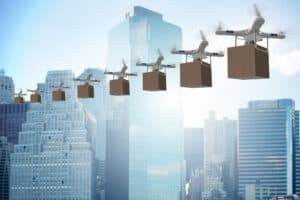
The Amazon drones could help relieve delivery congestion during peak travel times and provide valuable “last mile” support.
California and Texas are the two locations for Amazon’s brand-new delivery service based on drones. The states will see trials at specific sites as early as 2024 as Amazon debuts and perfects its latest design.
Amazon calls the trials “careful first steps,” and the company has a lot at stake. Drones could relieve pressure for fast delivery times while reducing vehicles on the road. In addition, drones might also provide faster deliveries for areas with fewer delivery drivers available.
Amazon has been working on this since 2013. Each autonomous drone has undergone several iterations in attempts to overcome early obstacles, and the latest design features improved durability and range.
Customers in trial areas will be able to use an app to order small items online. The drone will deploy to the person’s address and lower goods via an extendable tether, preventing the need to land. These drones could help relieve delivery congestion during peak travel times and provide valuable “last mile” support.
See also: AI-Powered Drones Make Sense of the Unknown
Obstacles to drone delivery still exist
The company is hoping to persuade regulators to allow drone travel. Commercial drone regulations are still somewhat strict, but the trials are part of what Amazon hopes will be a relaxing of those regulations.
In addition, Amazon’s design must overcome typical challenges to drone delivery. The machines must be robust enough to handle multiple types of weather and environmental conditions and reliable enough to provide a good customer experience for those waiting for deliveries.
Additionally, consumers themselves remain skeptical of drone delivery. Common concerns include noise levels, accuracy, and safety. Amazon and other companies working on the problem will need to prove that drones can deliver a valuable service while maintaining safety and earning customer support for launching at a much broader scale. If these trials succeed next year, we could see wider adoption very quickly.
FAA imposes limits on drones
An additional factor slowing the scope and scale of drone deliveries is rulings by the FAA. The agency has “blocked Amazon from flying over roads or people without permission on a case-by-case basis,” according to a recent Forbes article. As one might imaging, getting permission on a case-by-case basis would slow any company’s efforts to deploy drones down.




























